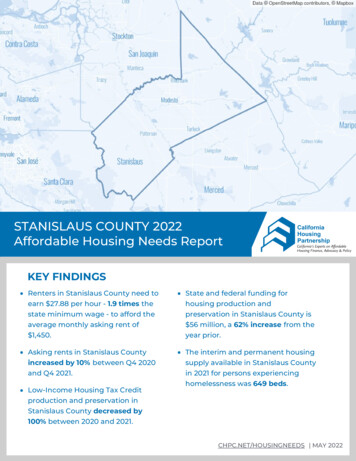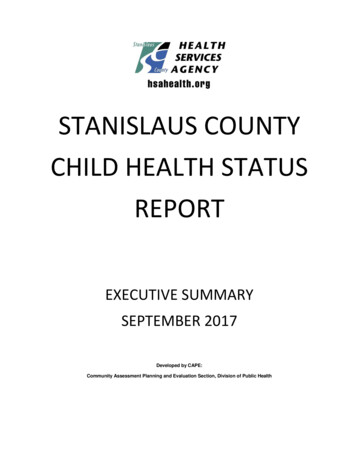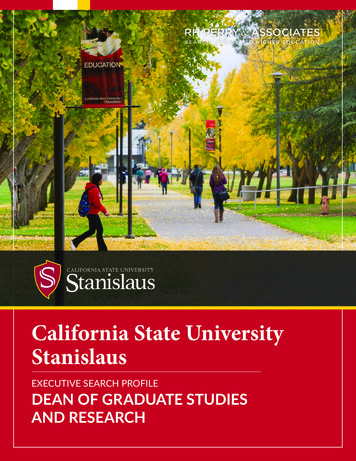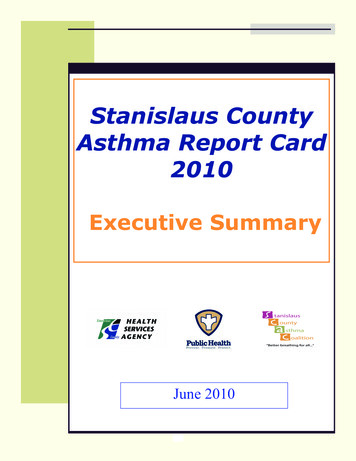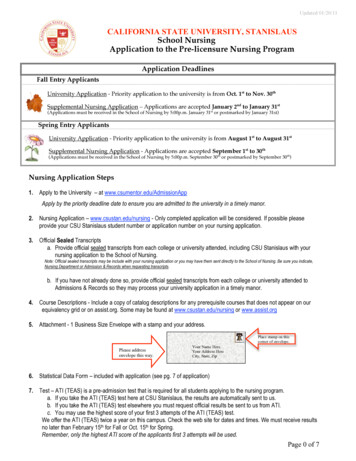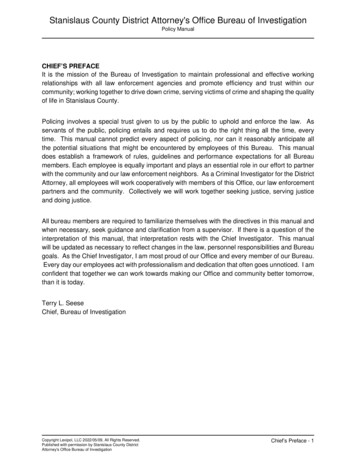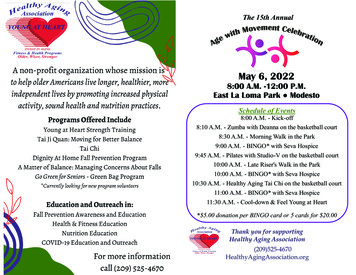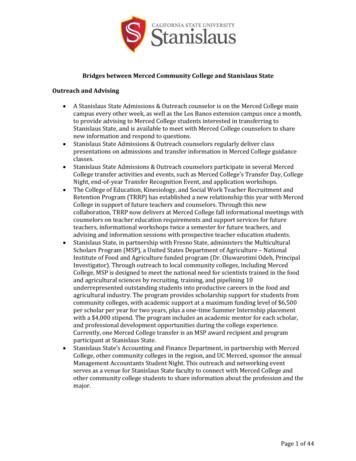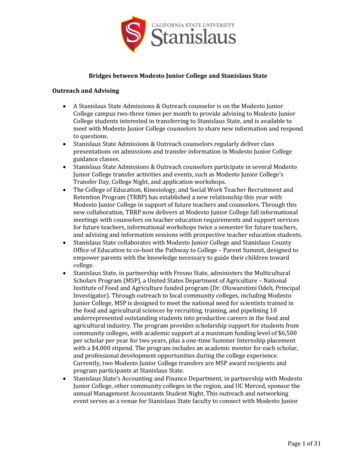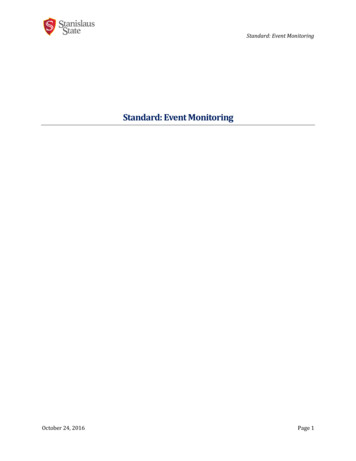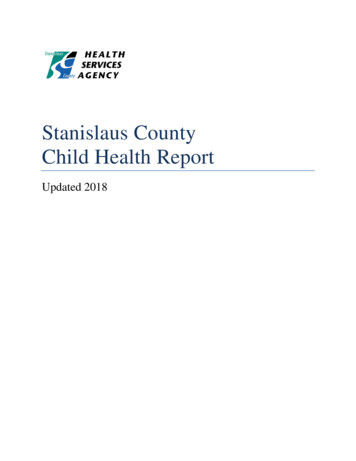
Transcription
Stanislaus CountyChild Health ReportUpdated 2018
This report was prepared by the Community Assessment, Planning and Evaluation (CAPE)Section of Public Health Division.Updated 2018Stanislaus County Health Service AgencyCAPE Section820 Scenic DriveModesto, California. 95350Phone (209) 558 4539Fax (209) 846 8881Email: CAPE@schsa.org1
AcknowledgementsTheresa Fournier, MPHKimberly Lindsey, MPHOlivia Tong, MSLeepao Khang, Ph. DSharon S. Hutchins, PhD., MPHJulie Falkenstein, PHN, MPAJulie Vaishampaiyan, MDLori Williams, MSW2
Table of ContentsPurpose/Introduction . 6Methods. 6Primary Data . 6Review and Analysis of Secondary Data . 6Statistical Stability . 7Privacy Concerns . 7Findings. 8Community Demographics and Well-Being . 8Population of children and adolescents and age distribution . 8Family and Household Structures . 9Racial and Ethnic Origin . 11Language . 12Social Support and Community Cohesion . 14Community Connectedness . 14School Participation . 16Disconnected Youth . 18Juvenile Arrest Rate . 19Education . 22Educational Attainment . 22Preschool and Kindergarten Enrollment . 23Young Children and Parent Book Reading. 25Third Grade Reading Score . 25Public School Enrollment . 27Dropouts and Truancy. 29High School Graduation . 33California Assessment of Student Performance and Progress (CAASPP) Testing . 33College Eligibility . 37Family Economics . 41Secure Parental Employment . 413
Employment Characteristics . 42Household Income . 42Poverty . 44Basic Needs . 46Food Insecurity . 47Child Care . 50Access to Health Care . 54Health Insurance Coverage . 54Usual Source of Care . 55Foregoing Needed Healthcare. 57Denti-Cal Coverage . 59Physical Health and Well-Being . 61Prenatal Care and Perinatal Health in Stanislaus . 61Childhood Asthma . 70Immunizations. 73Injuries . 75Nutrition . 78Physical Activity . 79Child and Youth Deaths . 81Child and Youth Safety. 84Bullying and Harassment at School . 84Child Abuse and Neglect . 86Dating and Domestic Violence . 89Foster Care . 92Gang Involvement . 99Mental and Behavioral Health . 102Tobacco Use. 102Alcohol Use . 103Illegal Drug Use . 105Mental Health. 108Depression-Related Feelings . 1084
Hospitalizations for Mental Health Issues . 111Conclusion . 114References . 1155
Purpose/IntroductionThe Stanislaus County Child Health Report was originally a supplement to the 2013 StanislausCounty Community Health Assessment produced by the Stanislaus County Health ServicesAgency / Public Health. The purpose of this report is to identify and assess issues and concernsthat are specific to younger residents of the county. While children were included in the 2013Community Health Assessment, this report highlights the particular experiences and needs ofresidents up to 18 years old and their families to inform programs providing outreach andservices for them as well as the community as a whole. In 2018, the report was revised andupdated to include the most current data available for each indicator.MethodsData for the Stanislaus County Child Health Report was compiled from primary data from the2013 Stanislaus County Community Health Assessment (CHA), and secondary sources.Primary DataThe primary CHA survey was administered to adults living in Stanislaus County to understandthe health and well-being of county residents. Surveys were available on paper in English andSpanish (and electronically in English), with data collection between April and August of 2013.Overall 2,056 surveys were collected from adults 18 and older. The data was analyzed andweighted for region, gender, and poverty status by the Family Health Outcomes Project (FHOP)at the University of San Francisco. Additional technical details about the CHA methodology anddata can be found in the 2013 CHA, available unty-Community-Health-Assessment.pdf .Review and Analysis of Secondary DataSecondary data includes information from multiple sources concerning the health and well-beingof Stanislaus County residents. The most updated data available from each source was used aswas available during updating in 2018.The following is a selected list of the secondary data sources used: American Community Survey (ACS) from the U.S. Census Bureau California Child Care Resources and Referral Network California Child Welfare Indicators Project California Department of Education California Department of Public Health6
California Health Interview Survey from the University of California Health PolicyInstituteCalifornia Healthy Kids SurveyCalifornia Student SurveyFeeding AmericaKidsData.orgW. Haywood Burns InstituteStatistical StabilityGiven the importance of having data for local decision makers to base their strategic planning,statistically non-significant or unstable results were sometimes reported within this documentand have been clearly marked. Caution is urged when interpreting these results.Privacy ConcernsIn order to protect the identity of participants, results for groups of less than 10 individuals, inwhich some demographic or other potentially identifying piece of information (following federalguidelines established in the Health Insurance Portability and Accountability Act [HIPAA]) wasgiven, are suppressed in this report (i.e. reported as 10). Other data was also censored when thereal values could be used to calculate a blocked value.7
FindingsCommunity Demographics and Well-BeingPopulation of children and adolescents and age distributionThe age distribution of a population can help to determine the type and extent of health issuesthat may impact the community. Knowledge of a populations’ age distribution is also a criticalcomponent for planning social service provisions and school enrollment needs. According to the 2015 American Community Survey (ACS), Stanislaus County has apopulation of 538,388 residents, with 146,061 below the age of 18. 10,918 babies were born in Stanislaus County from July 1, 2015-June 30, 2016. The median age of Stanislaus County (34.0) is slightly younger than the rest of California(36.2). (2015 ACS) Despite total numbers of children increasing, the percentage of the population made up ofchildren is decreasing, because the number of adults has also increased. The proportion of the population made up of children ages 0 to 17 has decreased between2000 and 2015, from 31.2% to 27.1%. (2000 U.S. Census, 2015 ACS) Figure 1 shows thechange in the proportion of children ages 0 to 5 and 6 to 17 in the population between thetwo time periods.Figure 1: Children and Adolescent Populations as a Percent of Total Population, StanislausCounty, 2000 and 20152000 CensusPercent of Total Population25%20%15%10%5%0%9.7%2015 ACS21.5%18.8%8.3%Age 0-5Age 6-17Data Source: US Census Bureau, 2000 US Census and 2015 American Community Survey.8
Family and Household StructuresFamily and household composition data can provide valuable information on the overall healthneeds of a community. In addition to health needs, this composition data also helps to estimateand observe utilization of local services and resources.Data from the 2012-2016 ACS showed that out of the 170,328 occupied households in StanislausCounty, 71,070 households (41.7%) had children less than 18 years of age.Householders are not always traditional biological parents of the children in their home. Thefive-year estimate from 2012-2016 (ACS) showed that 80.5% of children in Stanislaus Countyare the biological child of their householder (Table 1). Over eight percent of children under 18were living in the home of their grandparent, and over two percent were in a foster or otherunrelated relationship with the householder. For those children living in a grandparent’shousehold, for example, parents may or may not be present.Table 1: Relationship to Householder for Children under 18 in HouseholdsChild Relationship to HouseholderTotal:145,048Own Child:85.5%Biological Child80.5%Adopted Child1.7%Stepchild3.3%Grandchild8.6%Other relatives3.7%Foster child or other unrelated child2.2%Data Source: U.S. Census Bureau, American Community Survey 2012-2016 Table B09018Of children living with their parent(s), regardless of householder status (i.e., other relatives mayor may not be present), 63.0% live with two parents, 9.3% are living with father only, and 27.8% are living with mother only. (ACS, 2012-2016 Table B23008)Single-parent households have been rising nationally for decades (Vespa, Lewis & Kreider,2013). In the United States, the number of single-father-headed households increased drasticallybetween 1960 and 2011, from 297,000 to 2.6 million (Livingston, 2013). Approximately onepercent of U.S. households were headed by single fathers in 1960; by 2011, that percentage hadgrown to eight percent across the U.S., with single fathers accounting for a quarter of all singleparent households. This ratio holds true in Stanislaus County as well.9
The percentage of US households with children headed by grandparents has also been growing(Livingston and Parker, 2010). Grandparents often become the primary caregivers for theirgrandchildren when the parents are unable to do so. According to the 2012-2016 ACS, inStanislaus County, 17,712 grandparents live with their grandchildren (under 18),o 4,766 (26.9%) of these grandparents are financially responsible for theirgrandchildren’s basic needs.o 1,499 (8.5%) of grandparents that live with their grandchildren are responsible forthe children with no parent of the child present.Data from the 2013 primary CHA survey showed that amongst seniors 60 years of age and olderin Stanislaus County (N 343), 3.1% reported having children 0-5 living in the household.Respondents were not asked whether they were the head of household.The 2013 primary CHA survey asked about the marital and relationship status of participants, allof whom were at least 18 years of age. Table 2 shows the breakdown of relationship status byages of children in the household. Note that respondents were asked to indicate all relationshipcategories that apply to them (e.g. divorced individual now living with another partner), so thepercentages do not total 100%. Respondents with children in the household were more likely toreport being married or in a registered domestic partnership than respondents overall. Well overhalf (59.1%) of all respondents reported being married or in a registered domestic partnership.Table 2: Marital or Relationship Status of Stanislaus County AdultsRespondents with Children inHouseholdMarital/RelationshipAllStatus0 to 56 to 170 to 17RespondentsMarried or in a registered65.5%70.6%68.0%59.1%domestic partnershipIn a long-term relationship17.6%12.3%13.5%13.8%and/or living togetherSingle - never married10.1%8.2%9.1%13.8%Divorced or OTAL4877919982,033Data Source: FHOP, Stanislaus County CHA Community Survey, 201310
Racial and Ethnic OriginThe U.S. Census Bureau, following guidelines set by the U.S. Office of Management and Budget(Humes, Jones & Ramirez, 2011), currently classifies race and ethnicity within the followingdefined categories: race based on skin color and geographic origin; and ethnicity predominatelybased on language and culture.Latino/Hispanic is the only ethnic category included in the 2010 Census and recent AmericanCommunity Surveys. Due to this classification, one can be of any race and classified asHispanic/Latino or Not Hispanic or Latino.It is important to note that respondents to the U.S. Census and American Community Surveys(Humes, Jones & Ramirez, 2011) may have different concepts of race and ethnicity and answerthe separate race and ethnicity questions in unexpected ways. A sizeable percentage of Latinos,for example, report Latino/Hispanic/Spanish as their race. The U.S. Census Bureau reclassifiedthese individuals as some other (non-specified) race.Table 3: Race and Ethnicity of Children Age 0-17, Stanislaus County and California, 20122016RACE AND HISPANIC ORLATINO ORIGINOne raceWhiteBlack or African AmericanAmerican Indian andAlaska NativeAsianNative Hawaiian and OtherPacific IslanderSome other raceTwo or more racesHispanic or Latino origin(of any race)White alone, not Hispanicor LatinoStanislausCountyAges 0-1792.8%70.9%2.8%StanislausCounty AllAges95.7%74.7%2.7%CaliforniaAges 0-17CaliforniaAll %38.4%0.5%0.7%0.5%0.7%57.7%44.3%0.7%0.4%51.8%Data Source: U.S. Census Bureau, American Community Survey 2012-2016 Table S09010.7%0.4%38.6%Table 3 shows the identification with Census Bureau racial and ethnic groups for children ages0-17, and residents of all ages in Stanislaus County and California.11
Stanislaus County and California both have higher percentages of Hispanic/Latinochildren (57.7% Stanislaus, 51.8% California) than Hispanic/Latino general population(44.3% Stanislaus, 38.6% California).Stanislaus has lower percentages of non-White racial groups than California in everycategory except Native Hawaiian/Pacific Islander (0.7% Stanislaus, 0.4% California).Both California and Stanislaus total populations have near-equal percentages ofHispanic/Latino any race and White alone (Not Hispanic/Latino) (44.3% vs 44.1%Stanislaus, 38.6% vs 38.4% California).Kids are more likely to be multi-racial in both Stanislaus (7.2% kids, 4.3% all ages), andCalifornia (8.5% kids, 4.6% all ages).LanguageParticipants of the 2013 primary CHA survey were asked to indicate which language(s) theyspeak regularly. Higher percentages of participants with children in the household reportedregularly speaking Spanish than all respondents, while lower percentages of participants withchildren of any age living in the household reported regularly speaking English than allrespondents (see Table 4).Table 4: Language(s) Spoken in Everyday Life, 2013 CHA Community SurveyRespondents with Children inHouseholdOrigin ofAllLanguageLanguage 0 to 56 to 170 to ish36.7%33.2%31.6%25.6%Portuguese 1.1%1.4%1.3%1.2%Cambodian 2.6%1.3%1.9%1.4%Lao1.1%1.4%1.3%1.4%Southeast AsiaHmong0.9%0.9%0.9%0.8%Vietnamese 0.8%0.2%0.6%0.4%Assyrian1.6%2.0%2.0%1.5%Middle outh AsiansubcontinentHindi1.2%1.1%1.0%0.9%Pacific 6Data Source: FHOP, Stanislaus County CHA Community Survey, 201312
For children in school, mastery of English is of key importance because a language barrier candelay success in all subjects when children are unable to understand classroom instructions.California law prohibited bilingual instruction in public schools, from the 1998 induction ofProposition 227 until the 2016 passing of Proposition 58. The majority of English-learners inStanislaus and California are Spanish-speaking, with over 20% of students in Stanislaus schoolsclassified as English-learners who speak Spanish, as shown in Table 5 below.Table 5: English Learners in Public Schools by Learner Status, Stanislaus and 3-20142014-20152015-2016StatusStan. CAStan. CAStan. CAStan. CAStan. CAEnglish21.5% 18.9% 21.2% 18.3% 22.8% 19.1% 22.4% 18.7% 22.3% %2.6%3.6%2.5%3.6%2.4%3.6%(OtherLanguage)Not an75.9% 77.7% 76.3% 78.4% 74.6% 77.3% 75.0% 77.7% 75.0% 77.9%EnglishLearnerNote: Stan. is an abbreviation for Stanislaus County; CA is an abbreviation for California.Data Source: As cited on kidsdata.org, California Dept. of Education, English Learners by Grade and Language DataFiles and California Basic Educational Data System (CBEDS) (May 2015).13
Social Support and Community CohesionCommunity ConnectednessCaring adults in the community, as reported by students, may include but are not limited toteachers, coaches, spiritual leaders, and mentors. "Research indicates that children with at leastone caring adult in their lives (e.g., a relative, family friend, neighbor, after-school programworker, coach, etc.) are more likely to handle challenges well, show interest in learning,volunteer in the community, and get regular exercise; and they are less likely to feelsad/depressed and bully others.” (Kids Data, 2018)Figure 2: Caring Adults in the Community by Grade Level, Stanislaus 2011-2013Percent of Students Reporting Each PerceivedLevel of Caring from Community Adults100%80%60%40%20%0%High7th Grade68.3%Non-Traditional54.0%9th Grade11th .0%24.7%27.7%29.6%Data Source: As cited on kidsdata.org, California Department of Education, California Healthy KidsSurvey and California Student Survey (WestEd).9.7%8.8%10.2%Figure 2 shows the percentage of public-school students in grades 7, 9, 11, and non-traditionalstudents reporting a perceived level of caring from adults within their community. The level ofcaring is rated as high, medium, or low. A “high” level of agreement indicates that the studentstrongly agrees that adults in their community care about them. A “medium” level of agreementindicates that the student somewhat agrees that adults in their community care about them, and a14
“low” level of agreement indicates that the student is mostly not in agreement that adults in theircommunity care about them.Across all grades and non-traditional students, females reported slightly more high levels ofperceived caring (64.3%) than males (60.3%), shown in Figure 2. Non-traditional femalestudents reported the largest percentage of low perceived caring from adults (19%). OverallFigure 2 demonstrates that the majority of female and male students across all reporting gradeshave a perceived high level of caring adults in their communities, with the exception of malenon-traditional students reporting a majority in the medium level (46.3%). Notably, nontraditional students reported lower levels of caring than their traditional counterparts.Percent of Students Reporting Each PerceivedLevel of Caring from Community AdultsFigure 3: Caring Adults in the Community by Race/Ethnicity, Stanislaus Indian/AmericanAlaska/ BlackNativePercent High60.6%63.5%Percent Medium 28.8%24.0%Percent Low10.7%12.5%Asian56.5%32.2%11.4%NativeHispanic Hawaiian/ Latino / 69.4%24.5%6.1%Data Source: As cited on kidsdata.org, California Department of Education, California Healthy KidsSurvey and California Student Survey 11.6%Figure 3 depicts the same population as Figure 2 but broken down by race/ethnicity instead ofgrade and sex. In Stanislaus, Native Hawaiian and Pacific Islanders report the largest percentageof low agreement levels (18.8%) and smallest percentage of high agreement (54.8%), while15
White students report the smallest percentage of low agreement levels (6.1%) and the largestpercentage of high agreement levels (69.4%).School Participation“Participation is meaningful when contributions to the school and classroom environment arefacilitated, rather than directed, by adults. Meaningful participation at school helps cultivatestudents’ autonomy; decision–making and leadership skills; and personal talents and strengths.”(O’Malley & Amarillas, 2011) Students were asked how much they agree that they haveopportunities for meaningful participation at school, and over a third of all reporting grades (7th,9th, and 11th) and non-traditional students are in low agreement.Figure 4 illustrates that the majority of students, female and male, report a medium level ofagreement: 48.5% and 49.5% respectively. Non-traditional students reported low agreement(47.6% Female, 45.1% Male) more than any other group.Figure 4: Opportunities for Meaningful Participation at School (Student Reported)Stanislaus 2011-201380%70%60%50%40%30%20%10%0%7th Grade9th Grade11th %36.5%45.1%37.0%Data Source: As cited on www.kidsdata.org: California Department of Education, California Healthy KidsSurvey and California Student Survey (WestEd).16
Figure 5 shows the level of agreement in meaningful participation by race and ethnicity. Overone third of each race/ethnicity is in low agreement that opportunities for a meaningful level ofparticipation are available at school. The Hispanic/Latino youth reported the greatest amount oflow agreement (41.4%). While the majority of each race/ethnicity chose a medium level ofagreement, there is clearly a general concern for school connectivity among youth in StanislausCounty.Figure 5: Meaningful Participation at School, by Race/Ethnicity; Stanislaus 2011-201360%Percentage50%40%30%20%10%0%Percent HighPercent MediumPercent LowAfricanAmerican/ 0%50.3%38.8%Asian14.9%51.7%NativeHispanic/ HawaiianLatino/ r14.8%46.0%39.1%Data Source: As cited on kidsdata.org, California Department of Education, California Healthy Kids Survey and CaliforniaStudent Survey (WestEd).*This graph contains an unknown sample size, certain groups may be underrepresented.17
Disconnected YouthTeens who are not enrolled in school and not working are known as disconnected youth.“Disconnected youth are more likely to be poor, to have academic difficulties, to suffer frommental health problems and/or substance abuse, to be involved in violence, and to be teenparents.” (Hair, et. al, 2009) Figure 6 below shows a five-year trend (2011-2015) of Californiaand Stanislaus percentages of teens age 16-19 that are not in school and not working. Stanislaushas a consistently higher percentage of disconnected youth than California; however, over thefive-year period (2011-2015), Stanislaus has narrowed the gap by over three and a halfpercentage points (2011: 4.2 percentage points, 2015: 0.6 percentage points). In 2015, 7.3% ofStanislaus teens age 16-19 were not in school and not working, just half a percentage pointhigher than the State of California as a whole (6.7%).Percnet of Teens Age 16-19 Not in School andNot WorkginFigure 6: Disconnected Youth, Teens aged 16-19 Not in School and Not Working;Stanislaus and California, 201515.0%12.9%California11.4%10.0%8.7%Stanislaus 2201320142015Data Sources: As cited on kidsdata.org, U.S. Census Bureau, American Community SurveyCivic Enterprises’ report on “opportunity youth” (Belfield, Levin and Rosen, 2012) estimated anational lifetime tax burden of disconnected youth to be 1.6 trillion dollars. This includes losttaxes, added taxpayer-funded health care costs, criminal justice costs and welfare and socialservices. They estimated an average lifetime tax burden of a disconnected 16-year-old to be 258,040 per individual. Given these estimates and the current youth population, the taxpayerburden for one year of disconnected 16-year-olds in Stanislaus County could potentially be over80 m
According to the 2015 American Community Survey (ACS), Stanislaus County has a population of 538,388 residents, with 146,061 below the age of 18. 10,918 babies were born in Stanislaus County from July 1, 2015-June 30, 2016. The median age of Stanislaus County (34.0) is slightly younger than the rest of California (36.2). (2015 ACS)
